A simple power – based direction of arrival sensor
As can be seen, the world is at an explosive increasing rate with mobile communication.
Array antennas and base - stations are playing an important role to meet the demands of global
user equipments. With a large number of the user nowadays, adaptive signal processing array
known as the smart antenna, which commonly used in new generations mobile systems, can
locate mobile users by using DoA estimation techniques. The goal of direction of arrival (DoA)
estimation is to use the data received on the downlink at the base-station to estimate the
directions of the signals from the desired mobile users as well as the directions of interference
signals. The result of DoA estimation is used to determine the location of users so that the
maximum power towards the desired users while radiation nulls in the direction of interference
signals. Therefore, direction finding (DF) for multiple wireless devices is paid more attention in
communication applications. For examples, in the military, it is required to determine accurately
the position of a potential enemy. It can be accomplished by finding the direction of the coming
wave. Another application, in robotic technology, DF helps robots be aware of the around
obstructions without the external remote control. Direction of arrival (DoA) estimation was
found out and developed since the years of the last century. Watson Watt principle is a power –
based method in which the DoA is obtained from the ratio of the amplitude of received signals
applied on the x and y plane. The other method, which is phase – based, is accomplished by the
output signals from interferometer that helps to know the phase – difference of input signals [1].
The DoA estimation algorithm – based then is applied to determine the direction of the incident
wave. In [3], a low – complexity DoA estimation based on compressed MUSIC is investigated
with its performance analysis.

Trang 1
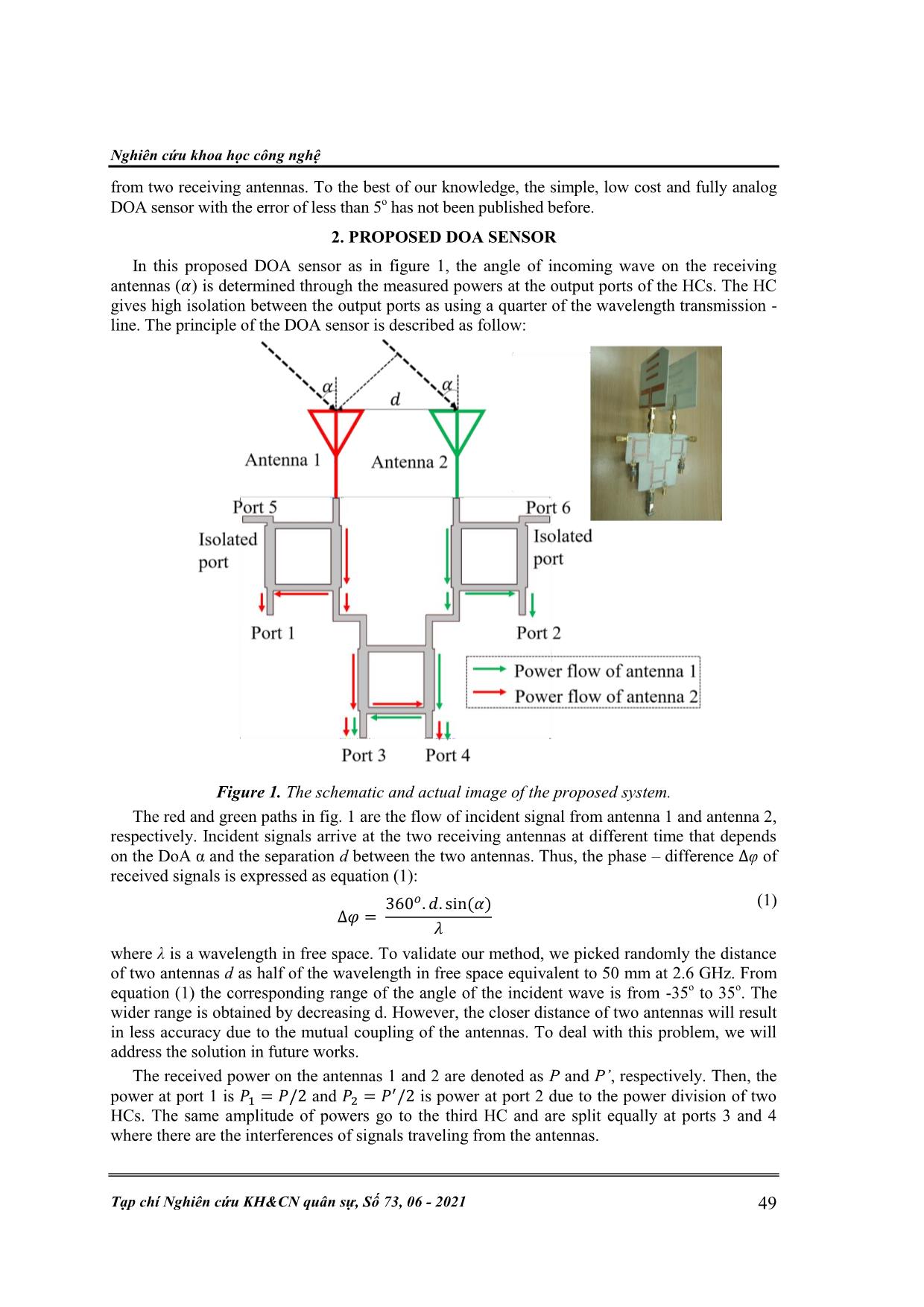
Trang 2
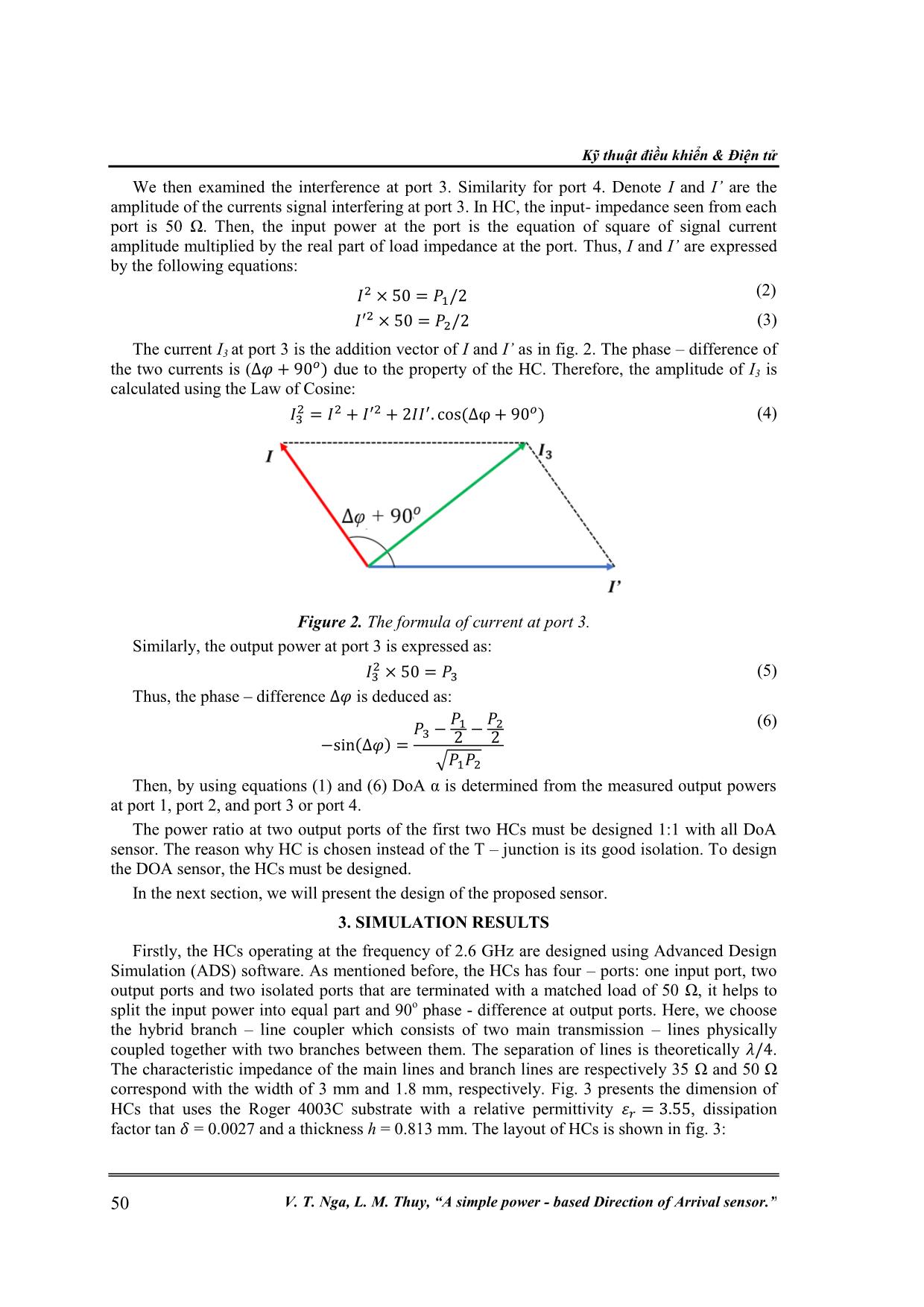
Trang 3
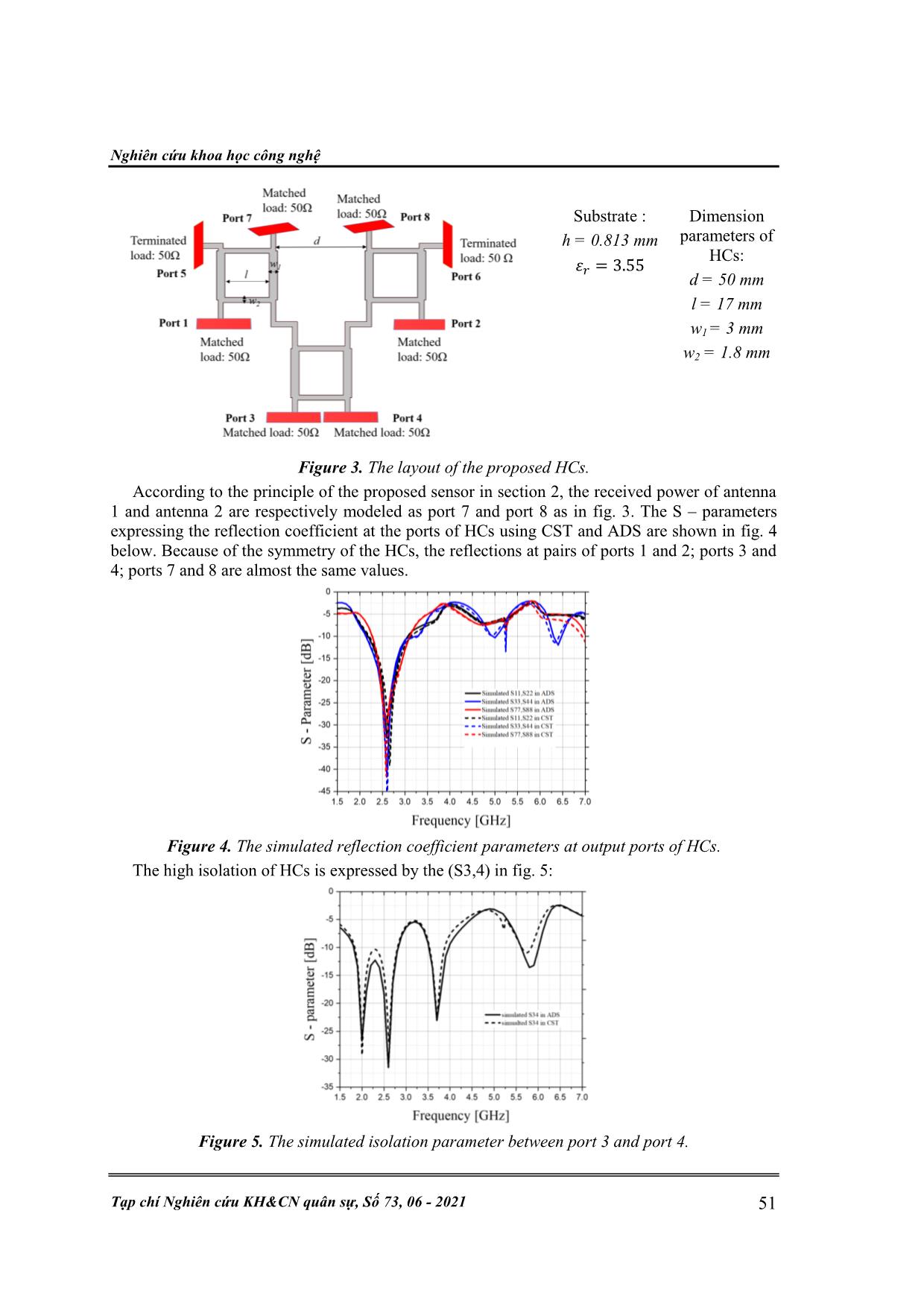
Trang 4
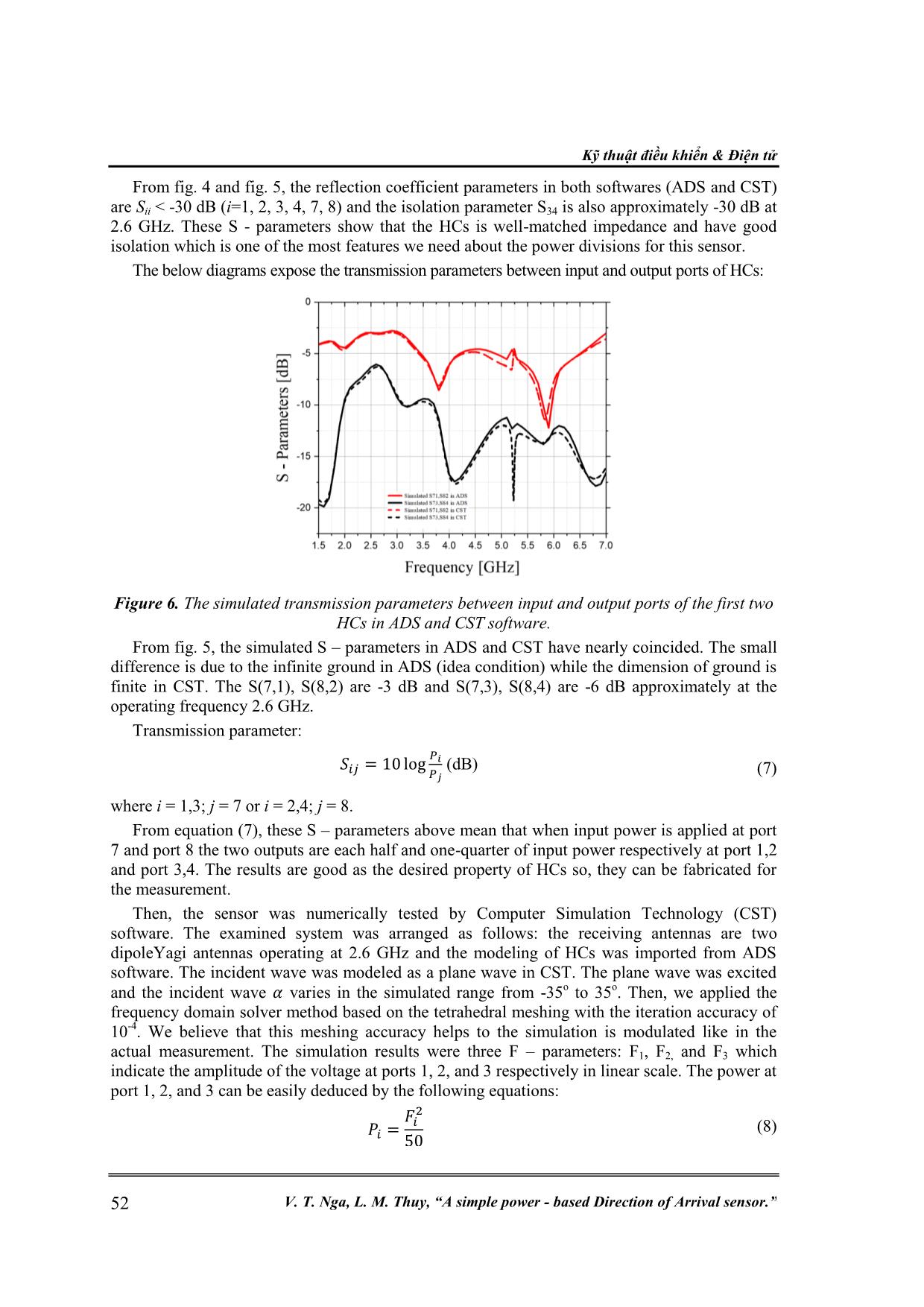
Trang 5
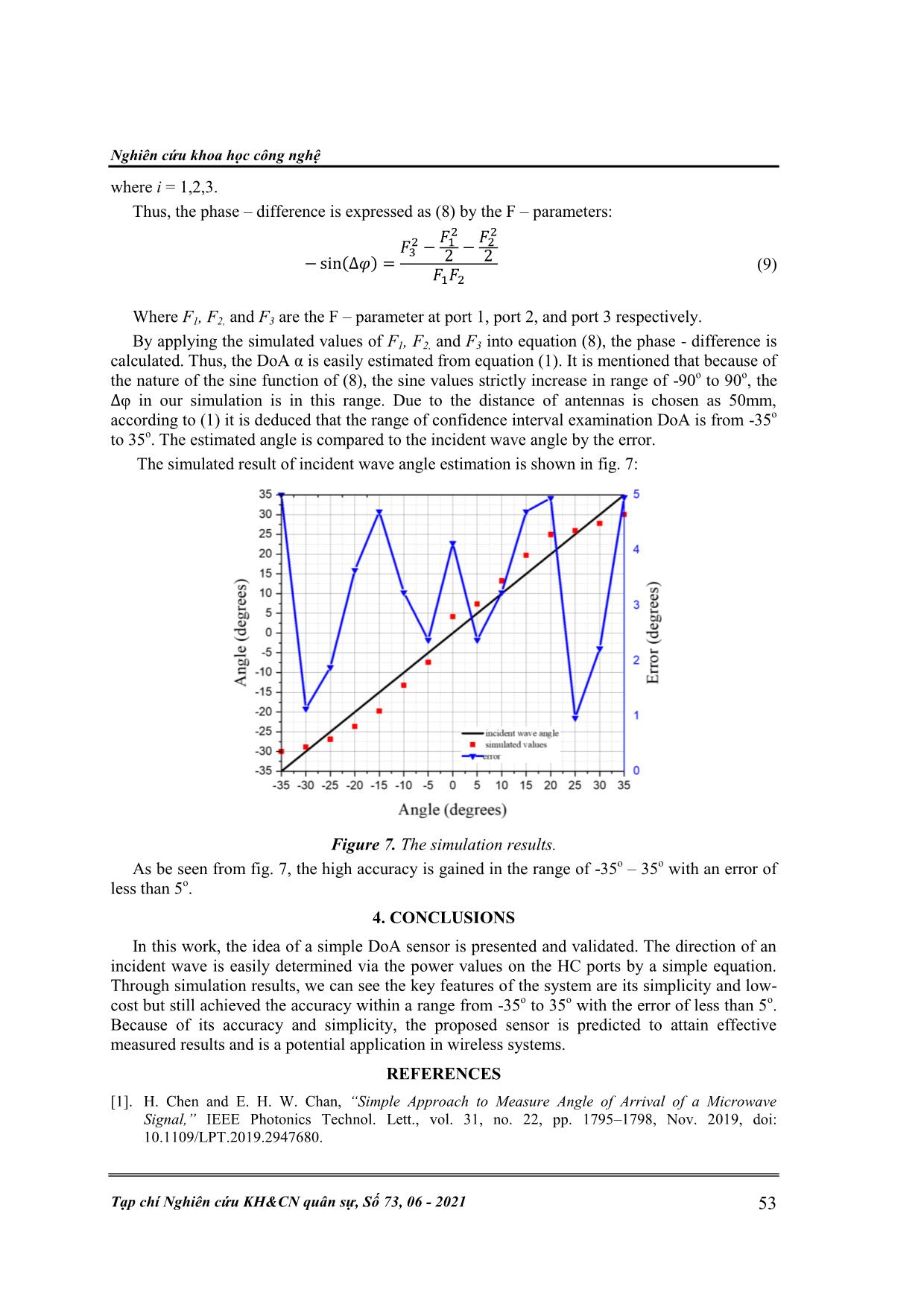
Trang 6
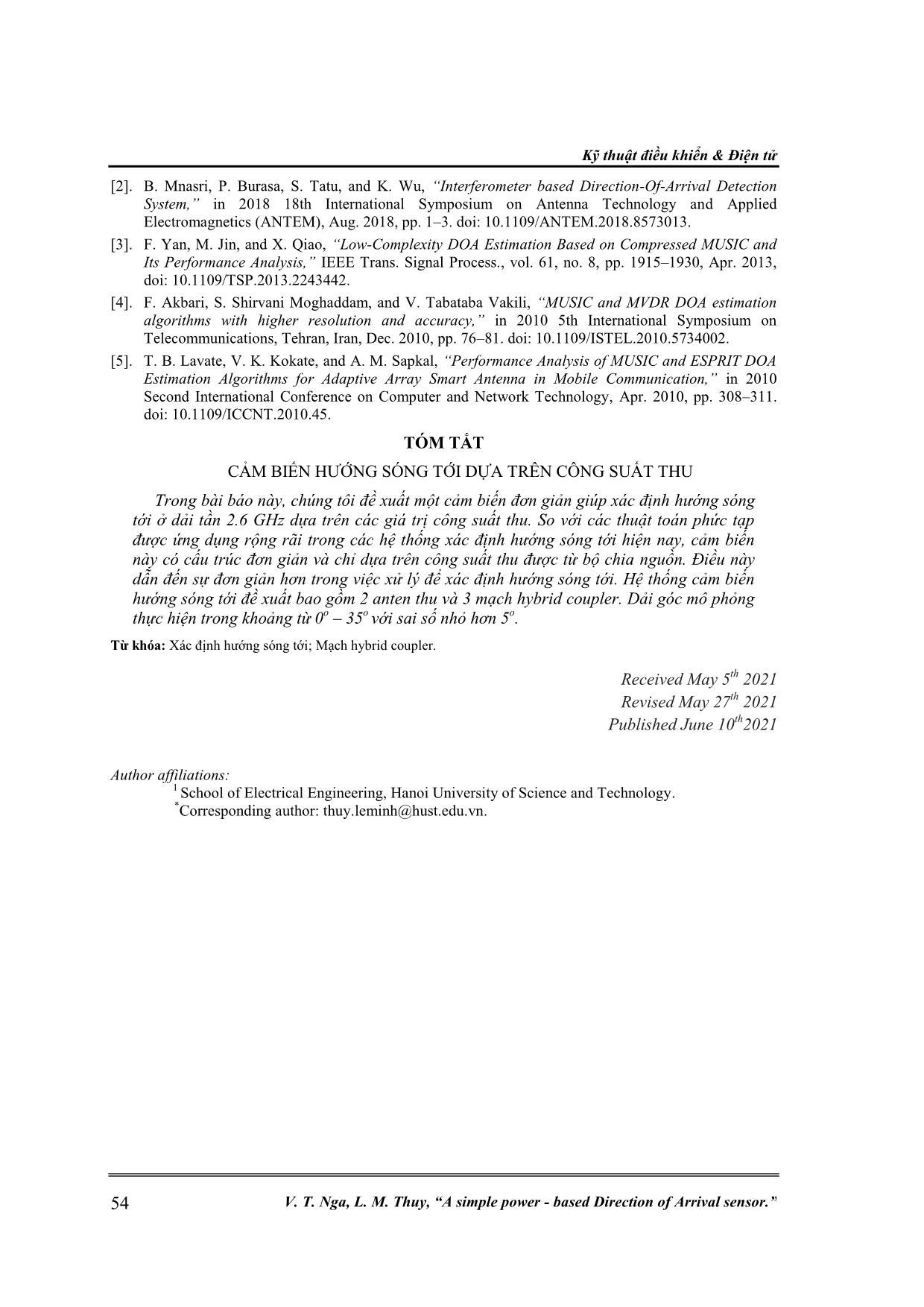
Trang 7
Tóm tắt nội dung tài liệu: A simple power – based direction of arrival sensor
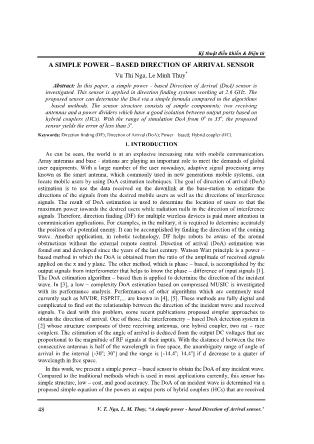
Kỹ thuật điều khiển & Điện tử 48 V. T. Nga, L. M. Thuy, “A simple power - based Direction of Arrival sensor.” A SIMPLE POWER – BASED DIRECTION OF ARRIVAL SENSOR Vu Thi Nga, Le Minh Thuy * Abstract: In this paper, a simple power - based Direction of Arrival (DoA) sensor is investigated. This sensor is applied in direction finding systems working at 2.6 GHz. The proposed sensor can determine the DoA via a simple formula compared to the algorithms – based methods. The sensor structure consists of simple components: two receiving antennas and a power dividers which have a good isolation between output ports based on hybrid couplers (HCs). With the range of simulation DoA from 0 o to 35 o , the proposed sensor yields the error of less than 5 o . Keywords: Direction finding (DF); Direction of Arrival (DoA); Power – based; Hybrid coupler (HC). 1. INTRODUCTION As can be seen, the world is at an explosive increasing rate with mobile communication. Array antennas and base - stations are playing an important role to meet the demands of global user equipments. With a large number of the user nowadays, adaptive signal processing array known as the smart antenna, which commonly used in new generations mobile systems, can locate mobile users by using DoA estimation techniques. The goal of direction of arrival (DoA) estimation is to use the data received on the downlink at the base-station to estimate the directions of the signals from the desired mobile users as well as the directions of interference signals. The result of DoA estimation is used to determine the location of users so that the maximum power towards the desired users while radiation nulls in the direction of interference signals. Therefore, direction finding (DF) for multiple wireless devices is paid more attention in communication applications. For examples, in the military, it is required to determine accurately the position of a potential enemy. It can be accomplished by finding the direction of the coming wave. Another application, in robotic technology, DF helps robots be aware of the around obstructions without the external remote control. Direction of arrival (DoA) estimation was found out and developed since the years of the last century. Watson Watt principle is a power – based method in which the DoA is obtained from the ratio of the amplitude of received signals applied on the x and y plane. The other method, which is phase – based, is accomplished by the output signals from interferometer that helps to know the phase – difference of input signals [1]. The DoA estimation algorithm – based then is applied to determine the direction of the incident wave. In [3], a low – complexity DoA estimation based on compressed MUSIC is investigated with its performance analysis. Performances of other algorithms which are commonly used currently such as MVDR, ESPRIT,... are known in [4], [5]. These methods are fully digital and complicated to find out the relationship between the direction of the incident wave and received signals. To deal with this problem, some recent publications proposed simpler approaches to obtain the direction of arrival. One of those, the interferometry – based DoA detection system in [2] whose structure composes of three receiving antennas, one hybrid coupler, two rat – race couplers. The estimation of the angle of arrival is deduced from the output DC voltages that are proportional to the magnitude of RF signals at their inputs. With the distance between the two consecutive antennas is half of the wavelength in free space, the unambiguity range of angle of arrival in the interval [-30 o ; 30 o ] and the range is [-14.4 o ; 14.4 o ] if decrease to a quater of wavelength in free space. In this work, we present a simple power – based sensor to obtain the DoA of any incident wave. Compared to the traditional methods which is used in most applications currently, this sensor has simple structure, low – cost, and good accuracy. The DoA of an incident wave is determined via a proposed simple equation of the powers at output ports of hybrid couplers (HCs) that are received Nghiên cứu khoa học công nghệ Tạp chí Nghiên cứu KH&CN quân sự, Số 73, 06 - 2021 49 from two receiving antennas. To the best of our knowledge, the simple, low cost and fully analog DOA sensor with the error of less than 5 o has not been published before. 2. PROPOSED DOA SENSOR In this proposed DOA sensor as in figure 1, the angle of incoming wave on the receiving antennas ( ) is determined through the measured powers at the output ports of the HCs. The HC gives high isolation between the output ports as using a quarter of the wavelength transmission - line. The principle of the DOA sensor is described as follow: Figure 1. The schematic and actual image of the proposed system. The red and green paths in fig. 1 are the flow of incident signal from antenna 1 and antenna 2, respectively. Incident signals arrive at the two receiving antennas at different time that depends on the DoA α and the separation d between the two antennas. Thus, the phase – difference φ of received signals is expressed as equation (1): (1) where λ is a wavelength in free space. To validate our method, we picked randomly the distance of two antennas d as half of the wavelength in free space equivalent to 50 mm at 2.6 GHz. From equation (1) the corresponding range of the angle of the incident wave is from -35 o to 35 o . The wider range is obtained by decreasing d. However, the closer distance of two antennas will result in less accuracy due to the mutual coupling of the antennas. To deal with this problem, we will address the solution in future works. The received power on the antennas 1 and 2 are denoted as P and P’, respectively. Then, the power at port 1 is and is power at port 2 due to the power division of two HCs. The same amplitude of powers go to the third HC and are split equally at ports 3 and 4 where there are the interferences of signals traveling from the antennas. Kỹ thuật điều khiển & Điện tử 50 V. T. Nga, L. M. Thuy, “A simple power - based Direction of Arrival sensor.” We then examined the interference at port 3. Similarity for port 4. Denote I and I’ are the amplitude of the currents signal interfering at port 3. In HC, the input- impedance seen from each port is 50 Ω. Then, the input power at the port is the equation of square of signal current amplitude multiplied by the real part of load impedance at the port. Thus, I and I’ are expressed by the following equations: (2) (3) The current I3 at port 3 is the addition vector of I and I’ as in fig. 2. The phase – difference of the two currents is ( due to the property of the HC. Therefore, the amplitude of I3 is calculated using the Law of Cosine: (4) Figure 2. The formula of current at port 3. Similarly, the output power at port 3 is expressed as: (5) Thus, the phase – difference is deduced as: √ (6) Then, by using equations (1) and (6) DoA α is determined from the measured output powers at port 1, port 2, and port 3 or port 4. The power ratio at two output ports of the first two HCs must be designed 1:1 with all DoA sensor. The reason why HC is chosen instead of the T – junction is its good isolation. To design the DOA sensor, the HCs must be designed. In the next section, we will present the design of the proposed sensor. 3. SIMULATION RESULTS Firstly, the HCs operating at the frequency of 2.6 GHz are designed using Advanced Design Simulation (ADS) software. As mentioned before, the HCs has four – ports: one input port, two output ports and two isolated ports that are terminated with a matched load of 50 Ω, it helps to split the input power into equal part and 90 o phase - difference at output ports. Here, we choose the hybrid branch – line coupler which consists of two main transmission – lines physically coupled together with two branches between them. The separation of lines is theoretically . The characteristic impedance of the main lines and branch lines are respectively 35 Ω and 50 Ω correspond with the width of 3 mm and 1.8 mm, respectively. Fig. 3 presents the dimension of HCs that uses the Roger 4003C substrate with a relative permittivity , dissipation factor tan = 0.0027 and a thickness h = 0.813 mm. The layout of HCs is shown in fig. 3: Nghiên cứu khoa học công nghệ Tạp chí Nghiên cứu KH&CN quân sự, Số 73, 06 - 2021 51 Substrate : h = 0.813 mm Dimension parameters of HCs: d = 50 mm l = 17 mm w1 = 3 mm w2 = 1.8 mm Figure 3. The layout of the proposed HCs. According to the principle of the proposed sensor in section 2, the received power of antenna 1 and antenna 2 are respectively modeled as port 7 and port 8 as in fig. 3. The S – parameters expressing the reflection coefficient at the ports of HCs using CST and ADS are shown in fig. 4 below. Because of the symmetry of the HCs, the reflections at pairs of ports 1 and 2; ports 3 and 4; ports 7 and 8 are almost the same values. Figure 4. The simulated reflection coefficient parameters at output ports of HCs. The high isolation of HCs is expressed by the (S3,4) in fig. 5: Figure 5. The simulated isolation parameter between port 3 and port 4. Kỹ thuật điều khiển & Điện tử 52 V. T. Nga, L. M. Thuy, “A simple power - based Direction of Arrival sensor.” From fig. 4 and fig. 5, the reflection coefficient parameters in both softwares (ADS and CST) are Sii < -30 dB (i=1, 2, 3, 4, 7, 8) and the isolation parameter S34 is also approximately -30 dB at 2.6 GHz. These S - parameters show that the HCs is well-matched impedance and have good isolation which is one of the most features we need about the power divisions for this sensor. The below diagrams expose the transmission parameters between input and output ports of HCs: Figure 6. The simulated transmission parameters between input and output ports of the first two HCs in ADS and CST software. From fig. 5, the simulated S – parameters in ADS and CST have nearly coincided. The small difference is due to the infinite ground in ADS (idea condition) while the dimension of ground is finite in CST. The S(7,1), S(8,2) are -3 dB and S(7,3), S(8,4) are -6 dB approximately at the operating frequency 2.6 GHz. Transmission parameter: (dB) (7) where i = 1,3; j = 7 or i = 2,4; j = 8. From equation (7), these S – parameters above mean that when input power is applied at port 7 and port 8 the two outputs are each half and one-quarter of input power respectively at port 1,2 and port 3,4. The results are good as the desired property of HCs so, they can be fabricated for the measurement. Then, the sensor was numerically tested by Computer Simulation Technology (CST) software. The examined system was arranged as follows: the receiving antennas are two dipoleYagi antennas operating at 2.6 GHz and the modeling of HCs was imported from ADS software. The incident wave was modeled as a plane wave in CST. The plane wave was excited and the incident wave varies in the simulated range from -35o to 35o. Then, we applied the frequency domain solver method based on the tetrahedral meshing with the iteration accuracy of 10 -4 . We believe that this meshing accuracy helps to the simulation is modulated like in the actual measurement. The simulation results were three F – parameters: F1, F2, and F3 which indicate the amplitude of the voltage at ports 1, 2, and 3 respectively in linear scale. The power at port 1, 2, and 3 can be easily deduced by the following equations: (8) Nghiên cứu khoa học công nghệ Tạp chí Nghiên cứu KH&CN quân sự, Số 73, 06 - 2021 53 where i = 1,2,3. Thus, the phase – difference is expressed as (8) by the F – parameters: (9) Where F1, F2, and F3 are the F – parameter at port 1, port 2, and port 3 respectively. By applying the simulated values of F1, F2, and F3 into equation (8), the phase - difference is calculated. Thus, the DoA α is easily estimated from equation (1). It is mentioned that because of the nature of the sine function of (8), the sine values strictly increase in range of -90 o to 90 o , the φ in our simulation is in this range. Due to the distance of antennas is chosen as 50mm, according to (1) it is deduced that the range of confidence interval examination DoA is from -35 o to 35 o . The estimated angle is compared to the incident wave angle by the error. The simulated result of incident wave angle estimation is shown in fig. 7: Figure 7. The simulation results. As be seen from fig. 7, the high accuracy is gained in the range of -35 o – 35o with an error of less than 5 o . 4. CONCLUSIONS In this work, the idea of a simple DoA sensor is presented and validated. The direction of an incident wave is easily determined via the power values on the HC ports by a simple equation. Through simulation results, we can see the key features of the system are its simplicity and low- cost but still achieved the accuracy within a range from -35 o to 35 o with the error of less than 5 o . Because of its accuracy and simplicity, the proposed sensor is predicted to attain effective measured results and is a potential application in wireless systems. REFERENCES [1]. H. Chen and E. H. W. Chan, “Simple Approach to Measure Angle of Arrival of a Microwave Signal,” IEEE Photonics Technol. Lett., vol. 31, no. 22, pp. 1795–1798, Nov. 2019, doi: 10.1109/LPT.2019.2947680. Kỹ thuật điều khiển & Điện tử 54 V. T. Nga, L. M. Thuy, “A simple power - based Direction of Arrival sensor.” [2]. B. Mnasri, P. Burasa, S. Tatu, and K. Wu, “Interferometer based Direction-Of-Arrival Detection System,” in 2018 18th International Symposium on Antenna Technology and Applied Electromagnetics (ANTEM), Aug. 2018, pp. 1–3. doi: 10.1109/ANTEM.2018.8573013. [3]. F. Yan, M. Jin, and X. Qiao, “Low-Complexity DOA Estimation Based on Compressed MUSIC and Its Performance Analysis,” IEEE Trans. Signal Process., vol. 61, no. 8, pp. 1915–1930, Apr. 2013, doi: 10.1109/TSP.2013.2243442. [4]. F. Akbari, S. Shirvani Moghaddam, and V. Tabataba Vakili, “MUSIC and MVDR DOA estimation algorithms with higher resolution and accuracy,” in 2010 5th International Symposium on Telecommunications, Tehran, Iran, Dec. 2010, pp. 76–81. doi: 10.1109/ISTEL.2010.5734002. [5]. T. B. Lavate, V. K. Kokate, and A. M. Sapkal, “Performance Analysis of MUSIC and ESPRIT DOA Estimation Algorithms for Adaptive Array Smart Antenna in Mobile Communication,” in 2010 Second International Conference on Computer and Network Technology, Apr. 2010, pp. 308–311. doi: 10.1109/ICCNT.2010.45. TÓM TẮT CẢM BIẾN HƯỚNG SÓNG TỚI DỰA TRÊN CÔNG SUẤT THU Trong bài báo này, chúng tôi đề xuất một cảm biến đơn giản giúp xác định hướng sóng tới ở dải tần 2.6 GHz dựa trên các giá trị công suất thu. So với các thuật toán phức tạp được ứng dụng rộng rãi trong các hệ thống xác định hướng sóng tới hiện nay, cảm biến này có cấu trúc đơn giản và chỉ dựa trên công suất thu được từ bộ chia nguồn. Điều này dẫn đến sự đơn giản hơn trong việc xử lý để xác định hướng sóng tới. Hệ thống cảm biến hướng sóng tới đề xuất bao gồm 2 anten thu và 3 mạch hybrid coupler. Dải góc mô phỏng thực hiện trong khoảng từ 0o – 35o với sai số nhỏ hơn 5o. Từ khóa: Xác định hướng sóng tới; Mạch hybrid coupler. Received May 5 th 2021 Revised May 27 th 2021 Published June 10 th 2021 Author affiliations: 1 School of Electrical Engineering, Hanoi University of Science and Technology. * Corresponding author: thuy.leminh@hust.edu.vn.
File đính kèm:
 a_simple_power_based_direction_of_arrival_sensor.pdf
a_simple_power_based_direction_of_arrival_sensor.pdf

